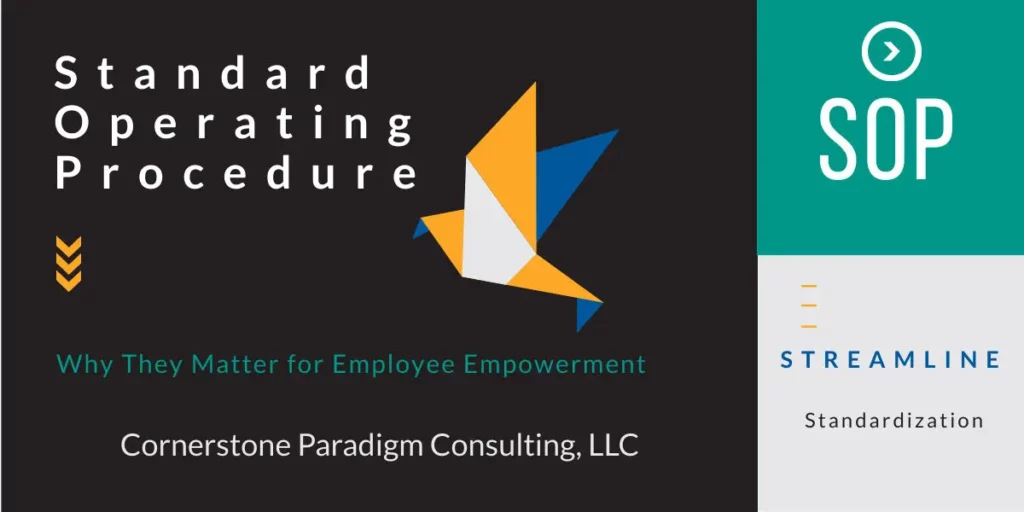Your Human Capital, otherwise known as your employees, is the company’s most valuable resource. It is not exactly a secret that they are not only the face of your company but the key to productivity, revenue, and innovation. When it comes to empowering your workforce and keeping them happy, typical advice includes vague suggestions like wellness days — but while these might play a role, they fail to address the root cause of the day-to-day problems.
Frequently, it is the intricate processes within organizations that act as barriers, hindering employees’ autonomy and potential. The persistent frustration experienced by employees in their daily operations can have a significant impact on their level of engagement with their work and the organization as a whole. Addressing and mitigating these frustrations is crucial in fostering a positive and productive work environment.
We’ll delve into a topic that is closely related yet slightly distinct: Standard Operating Procedures (SOP). These procedures serve as a crucial framework for operations within an organization, outlining the step-by-step processes that need to be followed to ensure consistency and efficiency. By establishing SOPs, employees are empowered with clear guidelines on how tasks should be executed, fostering a sense of structure and accountability in the workplace. In this exploration, we will discuss not only what SOPs entail but also their significant role in enhancing operational effectiveness and employee productivity. Let’s embark on this journey to unravel the intricacies of SOPs and uncover best practices for their implementation.
What are standard operating procedures?
Standard operating procedures, often referred to as “documents,” may not ignite excitement in most employees. However, these structured guidelines play a crucial role in ensuring consistency, efficiency, and quality in various business operations. So, let’s delve into their significance and how they contribute to organizational success.
While it may sound rigid or even overly formal for some companies, the purpose of a Standard Operating Procedure (SOP) is to meticulously outline a business process into smaller, more manageable steps. This breakdown aids the reader in navigating the process effectively. Think of it as an intricate instruction manual tailored for various business tasks, presented through formats like flowcharts, infographics, or comprehensive to-do checklists. The primary objective is to furnish an organization with clear, concise guidelines for executing tasks efficiently.
This practice of aligning processes across a company serves as a safeguard against complications that may emerge when different team members follow their distinct procedures. Furthermore, in cases where a particular procedure heavily relies on a sole key team member, such as when they are on vacation, absent due to illness, or have left the organization, it can result in notable disruptions and inefficiencies within the workflow.
Having all the information you need in one place has all kinds of benefits, including:
- Consistency
- Better quality
- Fewer errors
- Better compliance
- Saving time
- More knowledge retained
SOPs and employee empowerment
At first glance, it might seem like Standard Operating Procedures (SOPs) are solely focused on productivity. They often carry a negative reputation for being rigid and outdated. However, with the right execution, SOPs can transform into a valuable resource that equips your team for success.
Standard Operating Procedures (SOPs) serve as the backbone of efficient operations in many organizations. While some view them as restrictive, when implemented effectively, they provide a structured framework that enhances consistency, streamlines processes, and ensures compliance with industry standards. By fostering a culture of accountability and clarity, well-crafted SOPs empower teams to perform at their best, driving productivity and excellence across the board.
Standard Operating Procedures provide a structured framework for tasks, ensuring consistency and quality in operations. By documenting best practices and processes, SOPs help streamline workflows, reduce errors, and enhance overall efficiency within an organization. When implemented effectively, SOPs not only boost productivity but also foster a culture of continuous improvement and accountability among team members.
So, why do we emphasize the word “empowerment”? Well, properly crafted SOPs have the power to do just that. When articulated effectively, they empower your team members not only to assist themselves but also to guide them through the process of mastering new tasks in the way they are meant to be understood and accomplished. This empowerment fosters a culture of learning and growth within your organization.
People need consistency even those who hate consistency. Human nature tells us we want some things to be predictable. Ex: Red means stop, green means go, etc.
Few things are more stressful than not knowing what you’re supposed to be doing at work, but Standard Operating Procedures (SOPs) fill in all the gaps and provide a structured framework for tasks. SOPs serve as more than just a job description or a role and responsibility checklist; they act as a comprehensive guide outlining the best practices on “how to” execute specific tasks efficiently. If an employee ever finds themselves in doubt, they can simply refer to the SOP, ensuring clarity and facilitating seamless workflow.
Standard Operating Procedures (SOPs) are crucial documents that provide employees with clear guidelines and resources to understand precisely what is required for success. By outlining procedures and best practices, SOPs empower employees with the autonomy to handle tasks independently without constantly relying on managerial assistance for minor inquiries. This not only fosters efficiency but also cultivates a sense of ownership and accountability within the workforce.
Moreover, when individuals have a clear understanding of the outlined processes, they are more likely to engage actively by providing valuable suggestions or proposing improvements. This level of involvement fosters a sense of genuine ownership and accountability. (Also see continuous improvement, and process owners for complimenting information.)
Employee autonomy can lead to greater work satisfaction and feelings of well-being, so this is a huge benefit — especially as it’s likely to have a positive effect on the business. When employees feel empowered, they are more motivated to perform at their best, leading to higher productivity levels and overall organizational success.
When Standard Operating Procedures (SOPs) are integrated into training or employee performance evaluations, it ensures clarity on expectations. This structured approach allows individuals to verify that they have completed all required tasks during the onboarding process, fostering a comprehensive understanding of their roles and responsibilities within the organization.
SOPs and business continuity plans
SOPs are effective enough as a standalone policy, but they are best when combined with a business continuity plan, which allows a company and its employees to know what to do when unexpected events arise and create chaos. This preparedness is crucial for handling situations such as inclement weather, floods, fires, and other emergencies that may disrupt normal operations.
These plans focus on preventing certain outcomes from happening and determining how to mitigate problems if they do occur. Equipped with both Business Continuity Plans (BCPs) and Standard Operating Procedures (SOPs) readily available for reference, employees have a comprehensive toolkit at their disposal. This empowers them to navigate various situations independently, minimizing the need to escalate to managers for guidance. By having these resources easily accessible, employees can make informed decisions, maintain operational efficiency, and uphold organizational resilience in the face of challenges, fostering a culture of self-sufficiency and proactive problem-solving within the workforce.
For this to work properly, both documents must account for four different aspects:
- People
- Processes
- Technology
- Customer Experience
To strike the perfect balance and guarantee each component receives the attention it deserves, it can be beneficial to collaborate with our team in crafting these documents to ensure they are concise, direct, and highly impactful.
Show your employees you care
Standard Operating Procedures (SOPs) play a crucial role in setting your employees up for success. By clearly outlining the necessary steps for each process, SOPs empower employees to understand what it takes to excel and to consistently replicate each step with precision. Moreover, having detailed SOPs in place can also encourage employees to identify areas for improvement and offer valuable suggestions to optimize their operational processes. This level of engagement fosters a culture of continuous learning and growth within the organization.
Investing time and effort into creating effective SOPs demonstrates that you value your employees’ success and want to provide them with the necessary tools for their professional development. By showing your employees that you care about their growth and providing them with resources to succeed, you foster a positive work environment where individuals are empowered to take ownership and pride in their work.
In conclusion, Standard Operating Procedures (SOPs) are essential for any organization looking to promote efficiency, accountability, and organizational resilience. By empowering employees with clear guidelines and resources, SOPs allow for autonomy and active participation in improving processes. When combined with Business Continuity Plans, SOPs can also help organizations navigate unexpected challenges and maintain operational efficiency. Investing in creating effective SOPs not only benefits the company but also shows employees that their growth and development are valued, leading to a positive work culture. Therefore, it is crucial for organizations to regularly review and update their SOPs to ensure they are relevant and effective in achieving organizational goals. By continuously improving SOPs, companies can continue to foster a culture of learning, growth, and success. So even when SOPs seem complete, it is important to consistently assess and update them to ensure they are meeting the needs of both the organization and its employees. This level of commitment to excellence and continuous improvement demonstrates a dedication to success that sets organizations apart from their competitors.
If you’re interested in setting up SOPs for yourself (and maybe a business continuity plan too), we can help you. To find out more, book a no-obligation consultation today.







